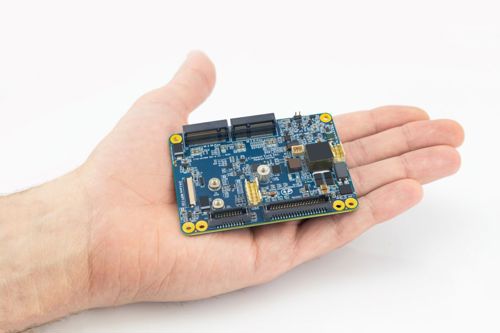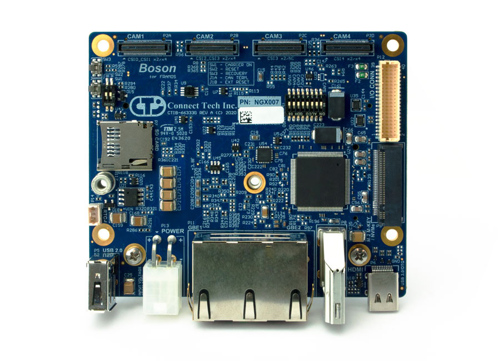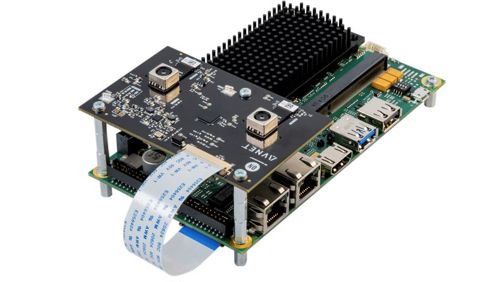Edge AI is where data is generated and processed at the edge of the network. It encompasses machine learning for autonomous applications, deep learning models and advanced algorithms on IoT devices, rather than using the cloud. Used in virtual assistants, video surveillance systems, retail, banking and financial services, automated optical inspection lines and, eventually, autonomous vehicles, edge AI reduces latency and increases control, compared with cloud computing.
The use of edge AI is typically in equipment where available space is restricted, for example door entry systems, industrial production lines or healthcare devices. This means that the end product has to be compact in design as well as efficient in operation.
This is where carrier cards can play a major role in the development of edge AI both when prototyping and at the proof-of-concept stage.
“The lightning-speed advancements of AI has revolutionised almost every industry and its potential for further innovation remains boundless,” said Michele Kasza, vice president of sales at Canadian hardware designer and manufacture, Connect Tech. “At the heart of every AI development lies the hardware infrastructure, with carrier boards and system level solutions playing a pivotal role in unlocking the full power of cutting-edge AI technologies as they act as a bridge between the AI processor and various peripheral devices,” she said.
In any design scenario, carrier cards (also called carrier boards and baseboards) carry signal and power to the computer on module/system on module (CoM/SoM) and house connectivity options and multimedia interfaces for the device as well as implement specific functionality for an application.
One of the advantages of a carrier board is that products can be rapidly designed using existing, known hardware. A board with a standard interface can be plugged into an existing module to introduce a specific function or upgrade without having to redesign the entire CoM or SoM.

Above: Connect Tech’s miniature Hadron brings edge AI to confined spaces.
Connect Tech is an Nvidia Elite partner and has a range of carrier boards for Jetson Orin modules. The modules target AI robotics with performance up to 275TOPS for multiple, concurrent AI inference channel pipelines and high-speed interface support for multiple sensors. Nvidia has introduced six models, 4GB and 8GB versions of the Nano, NX and AGX variants.
Among the portfolio are the Forge, Rogue and Hardon carrier boards. Each includes board support packages (BSP) bases on Nvidia’s latest JetPack and L4T releases and include critical drivers for images sensors and protocols, such as MIPI CSI-2, GMSL and FPD-Link, said Kasza.
“Without a robust BSP with integrated sensor support, time to market will be delayed; developing your own carrier board and BSP will easily add 12 months to ‘go-to-market’ plans,” Kasza added.
The Forge is a full featured carrier board for the Jetson AGX Orin module, specifically designed for commercially deployable platforms with extensive I/O options and a small footprint; Rogue is a rugged board which provides access to interfaces on the Orin AGX module and Hadron is a small, rugged carrier which at 82.6 x 58.8mm (3.25 x 2.31 inches) is just slightly larger than the module itself. This model is suitable for vision applications, inference and unmanned playloads, where its size can be exploited in space constrained designs.
The company also offers the Photon, Jetson AI camera platform, compatible with the Jetson Orin NX and Orin Nano modules, as well as the earlier Jetson Xavier NX and Nano modules. This is specifically design to support smart camera applications and fast deployment of vision-enabled AI applications which require multiple camera streams within a compact footprint, according to the company.
Described as an AI vision powerhouse, the Boson carrier board integrates up to three MIPI cameras in a small footprint (90 x 75mm (3.54 x 2.95 inches) and Boson’s compatibility with various Nvidia modules and expansive I/O options enable developers to build reliable, customised and high performing AI systems, said Kasza.

Above: The Boson carrier board’s sensor inputs and storage make it an “AI vision powerhouse”.
The Boson has a choice of sensor connectivity options – dual GbE and USB 3.1 with Wi-Fi and Bluetooth expansion ports also available.
It has the options of either four two-lane or three four-lane MIPI sensor modules to accelerate the development of vision systems. Four Framos PixelMate connectors are included on the card to connect directly to the MIPI CSI-2 cameras, negating the need for an adapter board and therefore reducing the overall height of the hardware stack.
In a vision system, the carrier card can be used to either increase the number of streams or the sources used at the existing frame to increase the machine capabilities on the same hardware. Alternatively, it can be used to run the same number of video streams to run additional AI models or vision streams on all incoming data to accelerate the vision system’s throughput.
A popular choice for edge AI is NXP Semiconductor’s i.MX 8M family of application processors. They are based on the Arm Cortex-A53 and Cortex-M4 cores which provide audio, voice and video processing for speech recognition, machine vision applications based on machine learning, AI and edge computing. They are also qualified to industrial standards making them suitable for continuous use in harsh environments and in unconditioned cabinets or enclosures without air flow as well as outdoor installations.

Above: Avnet’s AES-IMX8MPLUS-AI-DEV-KIT-G supports edge AI development with i.MX 8M+ -based SoM and SMARC industrial carrier card.
Developer kit
Avnet’s i.MX 8M Plus Edge AI development kit, for example, combines an i.MX 8M+ SMARC SoM and a SMARC industrial carrier card with a SMARC dual camera adapter from onsemi. There is also a 10.1 inch LVDS display and a 12V power adapter. The ensemble is designed for edge AI applications such as stereo vision, object detection and classification, face recognition and sequence analysis in factory and outdoor edge computing scenarios.
It can be used with the NXP eIQ machine learning development software to introduce inference engines, vision libraries and a machine learning workflow.
Vision in action
At this year’s Embedded World, Swiss embedded hardware and software provider, Toradex, used its Verdin i.MX 8M+ SoM, with a custom carrier board and Au-Zone’s Modular AI Vision kit in a machine learning, poseable droid. Au-Zone’s Maivin vision kit is a modular, full stack AI vision system incorporating a camera sensor, enclosure, connectivity and machine learning toolchain. In addition to supporting development, from prototype to production, it can also implement OTA (over the air) updates. Maivin is based on Toradex’s Verdin SoM with the i.MX 8M+, an integrated neural network processor, with 2.3TOPs processing capability.
For development and demonstration projects, the Toradex also offers the Dahlia carrier board which provides access to the most common features of its Verdin SoM range. The compact board is powered via a USB-C connector for USB-PD capability or by a barrel connector for applications ranging from 5.0 to 27V DC.
There are built-in UART to USB transceivers to allow the developer to monitor and communicate with UART interfaces via USB without requiring any additional serial port adapters. A DSI (display serial interface) to HDMI (high-definition multimedia interface) adapter is included.
The open-source embedded Linux OS, Torizon, can be integrated with development tools for software development and the company’s developer website has documentation, including reference designs for its off-the-shelf carrier boards and accessories. The reference designs include schematics, layouts and IPC-7351- compliant component libraries in Altium Designer format, and schematics are also available in PDF format.













